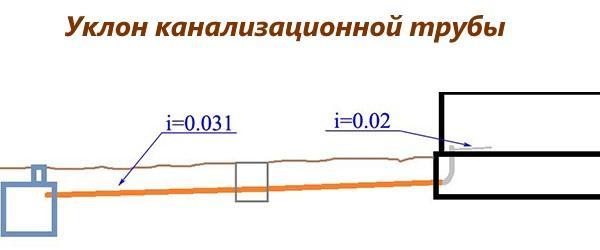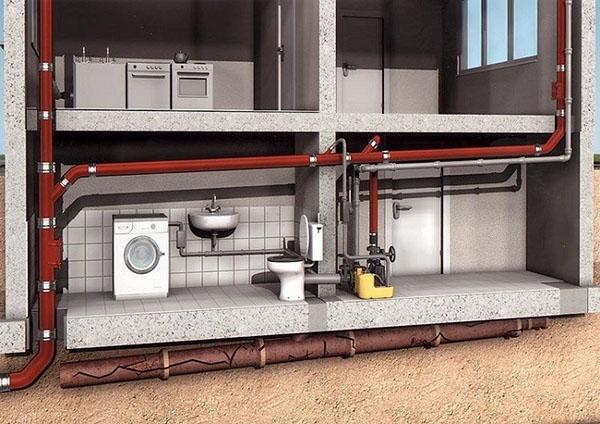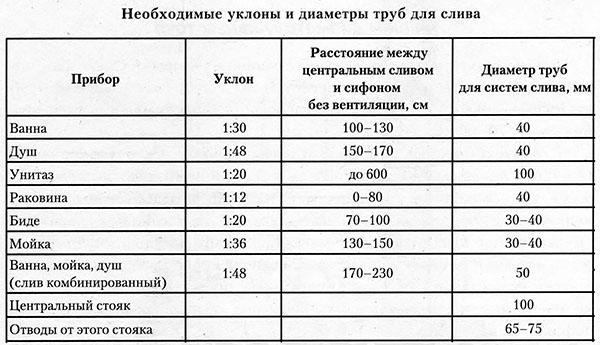What is the slope of the sewer pipe for effective wastewater disposal?
 A competent approach to creating a sewage system in a home requires strict adherence to the rules and regulations set forth in the regulatory documents. In order for the drainage system to work as efficiently as possible, it is necessary to observe the correct slope of the sewer pipe. From this publication, you will learn how to choose a slope based on the diameter, length and filling of the pipeline.
A competent approach to creating a sewage system in a home requires strict adherence to the rules and regulations set forth in the regulatory documents. In order for the drainage system to work as efficiently as possible, it is necessary to observe the correct slope of the sewer pipe. From this publication, you will learn how to choose a slope based on the diameter, length and filling of the pipeline.
What is the slope of the sewer pipe for?

Installation in compliance with the rules and regulations will help to avoid the following problems:
- Insufficient slope threatens with silting of the system, as a result of which the flow area of the outlet and main pipeline decreases. This, in turn, can lead to a water hammer that breaks the water locks in the siphons, which is the root cause of the appearance of sewage odors in the room. Silting up sooner or later will lead to the fact that the sewer pipe will not be able to cope with the movement of sewage, which will require measures to repair or replace a section of the system.
- Excessive slope of the sewer pipe leads to a decrease in its filling. With a strong slope, the liquid will pass too quickly, and all solid fractions will accumulate in the pipeline, which will lead to the settling of solid particles on the walls of the pipeline and an increase in the permissible noise level when sewage moves through the pipeline.
Steel and cast iron pipes must not be left empty. This leads to rapid corrosion due to the effect of oxygen on the pipeline walls.
To determine what the slope of the sewer should be, it is necessary to know the length, section and purpose of each section of the pipeline. The easiest way to determine the angle of inclination is to refer to the tables that are given in the reference books. One of these tables is given below.
In this table, slope is the slope in centimeters for each meter of pipe. For a bathroom, this is 1:30 or 33 mm / m running. For a shower, this is 1:48 or 48 mm / m running line.
Dependence of the angle of inclination on the diameter of the pipeline
 SNiP # 2.04.01 / 85, clause 18.2 says that pipes with a cross section of 40-50 mm should be laid with a slope of 0.03 m. A pipeline with a cross-section of 85 and 100 mm needs a slope of 0.02 m. The values in the form of fractions show the difference in section heights pipeline 1 m long. Based on this, the slope of the sewage system for 1 meter of a pipe with a cross section of 50 mm will be 0.03 m or 30 mm.
SNiP # 2.04.01 / 85, clause 18.2 says that pipes with a cross section of 40-50 mm should be laid with a slope of 0.03 m. A pipeline with a cross-section of 85 and 100 mm needs a slope of 0.02 m. The values in the form of fractions show the difference in section heights pipeline 1 m long. Based on this, the slope of the sewage system for 1 meter of a pipe with a cross section of 50 mm will be 0.03 m or 30 mm.
The slope values in the code of practice are for guidance only. Due to the complexity of the relief, it happens that it is impossible to carry out the installation in compliance with the data specified in SNiP. In this case, laying with the smallest slope of the sewer pipe is allowed.
In SNiP №2.04.03 / 85, there is an explanation regarding the slope of the sewer pipeline with a passage section of 150-200 mm. In simple words, the remark says that under certain conditions for individual sections of the network, it is possible to operate with slopes with the value:
- for pipes with a section of 200 mm, the minimum slope can be 0.005 m;
- for branch systems with a pipeline diameter of 150 mm - 0.007 m.
You can independently calculate the minimum angle of inclination of the sewer pipe in a private house using the formula: U = L × Y. Where:
- U is the calculated value of the slope;
- L is the length of the section of the branch system;
- Y is the minimum slope.
According to regulatory documents, the maximum slope of the sewer pipe should not exceed 0.15 m or 150 mm per 1 running line.
Calculation of the slope of external drainage systems
 The installation of the external sewage pipeline must be performed with the required angle of inclination to ensure effective drainage of wastewater by gravity. As a rule, pipes with a diameter of 110, 150 and 200 mm are used for laying external sewerage networks.
The installation of the external sewage pipeline must be performed with the required angle of inclination to ensure effective drainage of wastewater by gravity. As a rule, pipes with a diameter of 110, 150 and 200 mm are used for laying external sewerage networks.
According to regulatory documents, the slope of the 110 mm sewer pipe is 0.02 m / linear m. To calculate the slope of a section of the system, multiply the length of the system by the recommended slope.
Example
On a 15 m section, the difference between the end sections of the system will be: 15 x 0.02 m = 0.3 m or 30 cm.
For elements with a passage section of 150 mm, the recommended slope is 0.008 m.If it is impossible to organize the required angle of inclination of the system, it is allowed to use the minimum permissible value of 0.007 m.
When used in the external drainage system of pipes with a section of 200 mm, the slope value is 0.007 m.If necessary, this value can be reduced to 0.005 m.
Calculation of the slope of the system by filling
 The value of filling allows you to determine the speed of movement of wastewater, which in turn is an extremely important indicator for determining the optimal angle of inclination of a pipeline made of plastic, asbestos-cement or cast iron elements.
The value of filling allows you to determine the speed of movement of wastewater, which in turn is an extremely important indicator for determining the optimal angle of inclination of a pipeline made of plastic, asbestos-cement or cast iron elements.
The calculation of occupancy is calculated using the formula Y = H / D, where:
- Y is the estimated value of occupancy;
- H - liquid level in the pipeline section;
- D - flow area.
Based on SNiP 2.04.01-85, the occupancy (Y) can be in the range from 0.3 to 1. In practice, this value must fulfill the condition: 0.3 There is an optimal filling factor for various materials: Initial data: plastic sewer pipe, 110 mm in diameter. Let's take the value of H - equal to 0.6 (60 mm). Using the formula Y = H / D we get: Y = H (60) / D (110) = 0.55. To check the fulfillment of the conditions, it is necessary to compare the obtained value with the optimal filling factor. For this, we use the condition K ≤ V√ y, where: We get: 0.5 ≤ 0.7√ 0.55. The condition is met, since 0.5 ≤ 0.52 How to withstand the required slopes? Beat off the level using a specialized tool (water, laser level or level), after which you should draw a laying diagram on the wall, the lines of which should be used to create strobes at each section of the system. If it is impossible or impractical to chase the walls, use special wall holders to fix the elements. All data given in regulatory documents are recommended and are not binding. On the basis of SNiP, the minimum depth of the sewer pipes should vary within 300 - 500 mm from the ground surface:
Calculation example
Installation of internal sewerage
 When laying an internal wastewater disposal system, it is necessary to maintain the required slope, avoiding sagging and bending of elements in the areas sewerage system... When installing the system, it must be borne in mind that at each section, depending on the purpose and section of the pipeline, it is necessary to observe a different angle of inclination. For clarity, we suggest that you familiarize yourself with the table of slopes of elements from various drainage points.
When laying an internal wastewater disposal system, it is necessary to maintain the required slope, avoiding sagging and bending of elements in the areas sewerage system... When installing the system, it must be borne in mind that at each section, depending on the purpose and section of the pipeline, it is necessary to observe a different angle of inclination. For clarity, we suggest that you familiarize yourself with the table of slopes of elements from various drainage points.
Rules for laying pipes for an external drainage system
 The external sewerage system is laid in trenches. The slope of the pipe and the depth of laying the external sewage system are regulated by SNiP 2.04.01-85, clause 18.2 and SNiP 2.04.03-85.
The external sewerage system is laid in trenches. The slope of the pipe and the depth of laying the external sewage system are regulated by SNiP 2.04.01-85, clause 18.2 and SNiP 2.04.03-85.
 For effective drainage, the system must be made without turns. If the ground relief does not allow laying the pipeline in a straight line, experts recommend installing a tee at the turn, bringing the vertical element above the soil level and plugging it. Thus, you will create an impromptu revision well, which will make it easy to clean blockage at the turning point.
For effective drainage, the system must be made without turns. If the ground relief does not allow laying the pipeline in a straight line, experts recommend installing a tee at the turn, bringing the vertical element above the soil level and plugging it. Thus, you will create an impromptu revision well, which will make it easy to clean blockage at the turning point.How to properly lay sewer pipes - video